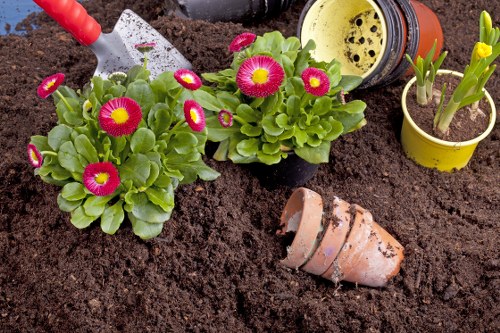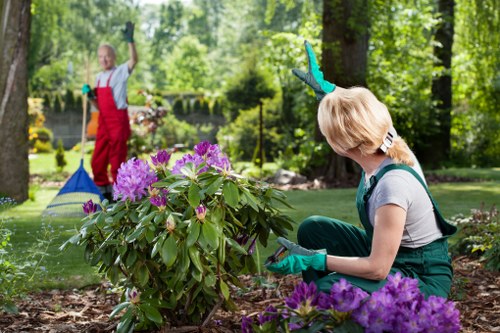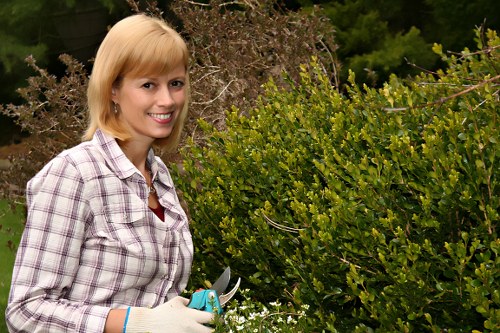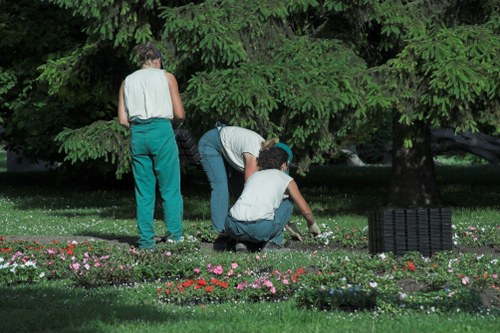Hedge Trimming in Staines: A Comprehensive Guide to Maintaining Beautiful Gardens

Maintaining a stunning garden in **Staines** starts with regular hedge trimming. Properly trimmed hedges not only enhance the beauty of your outdoor space but also promote the health and longevity of your plants. Whether you're a seasoned gardener or a homeowner looking to improve your garden's appearance, understanding the nuances of hedge trimming is essential.
Hedge trimming is more than just cutting back overgrown branches; it's an art that requires knowledge of different plants, the right tools, and the correct techniques. In **Staines**, where the climate and soil conditions can vary, tailoring your hedge trimming practices to local conditions is crucial for optimal results.
In this guide, we'll explore the best practices for hedge trimming in **Staines**, including the types of hedges commonly found in the area, the tools you'll need, and step-by-step instructions to achieve professional-looking results.

The Importance of Regular Hedge Maintenance
Regular hedge maintenance is vital for several reasons. Firstly, it encourages healthy growth by removing dead or diseased branches, allowing sunlight and air to penetrate the foliage. This helps prevent pests and diseases from taking hold, ensuring your hedges remain robust and vibrant.
Secondly, well-maintained hedges contribute to the overall aesthetics of your garden. They provide structure, create privacy, and can serve as a natural barrier against noise and wind. In suburban areas like **Staines**, where gardens are a key feature of residential properties, maintaining hedges can significantly enhance curb appeal.
Lastly, regular trimming helps control the size and shape of your hedges, preventing them from becoming unruly and difficult to manage. This proactive approach saves time and effort in the long run, making garden maintenance more manageable.

Choosing the Right Tools for Hedge Trimming
Essential Tools for Precision Trimming
Having the right tools is fundamental to achieving a neat and precise hedge trim. The primary tools you'll need include:
- Pruning Shears: Ideal for small branches and detailed work.
- Hedge Trimmers: Available in manual, electric, and gas-powered models for cutting larger sections.
- Loppers: Perfect for thicker branches that pruning shears can’t handle.
- Gardening Gloves: Protect your hands from thorns and debris.
- Safety Goggles: Essential for eye protection during trimming.
Investing in high-quality tools ensures efficiency and reduces the risk of injury. Regular maintenance of these tools, such as sharpening blades and cleaning, will extend their lifespan and performance.
Choosing the Right Hedge Trimmer
Selecting the appropriate hedge trimmer depends on the size and type of hedges you have. For small to medium-sized hedges, electric trimmers are sufficient and environmentally friendly. However, for larger hedges or frequent trimming, a gas-powered trimmer may be more effective due to its power and mobility.

Best Practices for Hedge Trimming
Timing Your Trims
Timing is crucial when it comes to hedge trimming. The best time to trim most hedges in **Staines** is during the late spring or early summer, after the plant has established new growth. Avoid trimming during extreme weather conditions, such as frost or heatwaves, which can stress the plants.
Regular trimming schedules, typically once or twice a year, help maintain the desired shape and size of your hedges. However, some fast-growing species may require more frequent maintenance to prevent overgrowth.
Trimming Techniques
Proper trimming techniques ensure that your hedges remain healthy and aesthetically pleasing. Here are some key techniques to follow:
- Start with the Right Shape: Determine the desired shape of your hedge, whether it's formal or informal.
- Maintain Evenness: Trim the sides and top uniformly to achieve a balanced appearance.
- Cut at the Right Angle: Make clean cuts at a slight angle to prevent water from pooling on the foliage.
- Don’t Overtrim: Remove no more than one-third of the hedge’s growth at a time to avoid stressing the plant.
- Clean Up Debris: Remove all trimmed branches and leaves to prevent disease and pests.

Common Hedges in Staines and Their Specific Needs
Boxwood (Buxus)
Boxwood is a popular choice for formal hedges in **Staines** due to its dense foliage and ability to maintain a precise shape. Regular trimming is essential to prevent leggy growth and to encourage a compact form. Use sharp shears to achieve clean cuts, and avoid cutting into old wood, which doesn't regenerate.
Privet (Ligustrum)
Privet hedges are valued for their rapid growth and adaptability. They respond well to both pruning and trimming, making them ideal for creating tall, privacy screens or lower, decorative borders. Regular maintenance helps keep privet hedges in check and promotes healthy growth.
Laurel (Prunus)
Laurel hedges are known for their glossy leaves and resilience. They can grow quite tall, so regular trimming is necessary to maintain their shape and size. Laurel thrives with back-to-front trimming, where the back of the hedge is trimmed higher than the front to allow sunlight to reach all sides.
Holly (Ilex)
Holly hedges provide year-round greenery and vibrant berries, adding color to your garden. When trimming holly, it's important to remove any dead or damaged branches and to maintain an open center to allow light penetration. Holly can handle heavy trimming, making it suitable for shaping into various forms.

Eco-Friendly Hedge Trimming Practices
Minimizing Waste
Adopting eco-friendly hedge trimming practices not only benefits your garden but also the environment. Composting trimmed branches and leaves reduces waste and recycles nutrients back into the soil. Avoid burning or sending green waste to landfills, as this can contribute to pollution.
Using Sustainable Tools
Choose tools that are durable and have a longer lifespan to reduce the need for frequent replacements. Electric hedge trimmers are more environmentally friendly compared to gas-powered ones, as they produce fewer emissions. Additionally, maintaining your tools ensures they operate efficiently and last longer.
Water Conservation
Proper trimming can also aid in water conservation. Well-maintained hedges require less watering as they are healthier and better structured to retain moisture. Mulching around the base of your hedges helps retain soil moisture and reduce evaporation.
Implementing these sustainable practices not only promotes a healthy garden but also supports environmental conservation efforts in **Staines**.

Hiring Professional Hedge Trimming Services in Staines
When to Consider Professional Help
While DIY hedge trimming can be rewarding, there are times when hiring professionals is the best option. If your hedges are extensive, have intricate shapes, or are located in hard-to-reach areas, professional services can ensure precise and safe trimming. Additionally, professionals have the expertise to handle various hedge types and can provide tailored maintenance plans.
Choosing the Right Service Provider
When selecting a hedge trimming service in **Staines**, consider the following factors:
- Experience: Look for providers with a proven track record and positive reviews.
- Licensing and Insurance: Ensure the company is properly licensed and insured to protect against potential damages.
- Services Offered: Choose a provider that offers comprehensive services, including trimming, shaping, and maintenance.
- Cost: Obtain quotes from multiple providers to ensure competitive pricing without compromising quality.
- Customer Service: Excellent communication and responsiveness are indicators of a reliable service provider.
Benefits of Professional Trimming
Hiring professionals brings several advantages, such as:
- Expertise: Professionals understand the specific needs of different hedge species and can execute precise trimming techniques.
- Time-Saving: Outsourcing hedge trimming frees up your time to focus on other aspects of garden care or personal activities.
- Safety: Trimming large or tall hedges can be hazardous. Professionals have the necessary equipment and training to perform the job safely.
- Consistent Results: Regular professional maintenance ensures your hedges remain well-shaped and healthy throughout the year.

Maintaining Trimmed Hedges
Post-Trimming Care
After trimming your hedges, proper care is essential to support their recovery and growth. Here are some post-trimming maintenance tips:
- Watering: Ensure your hedges receive adequate water, especially during dry spells, to aid in recovery.
- Fertilizing: Apply a balanced fertilizer to provide essential nutrients that promote healthy growth.
- Mulching: Add a layer of mulch around the base to conserve moisture and suppress weed growth.
- Pest Control: Inspect your hedges regularly for signs of pests or diseases and address issues promptly.
Regular Inspection
Regularly inspect your hedges to identify any issues early. Look for signs of stress, such as discoloration, wilting, or abnormal growth patterns. Early detection allows for timely intervention, preventing minor issues from escalating into significant problems.
Maintaining your hedges goes beyond trimming. Proper care ensures that your outdoor space remains a beautiful and serene environment for you and your family to enjoy.

Seasonal Hedge Trimming Tips
Spring Trimming
Spring is an ideal time for hedge trimming as it coincides with the onset of new growth. Trim your hedges in early spring before buds break to encourage bushier growth. This timing helps your hedges recover quickly and maintain their shape throughout the growing season.
Summer Trimming
During the summer, focus on light pruning to shape your hedges and remove any stray branches. Avoid heavy trimming in the heat, as it can stress the plants. Ensure adequate watering and consider pruning in the cooler parts of the day to minimize heat stress.
Autumn Trimming
Autumn trimming helps prepare your hedges for the winter months. Remove any dead or diseased branches and shape the hedges to allow proper airflow. This reduces the risk of frost damage and pests during the colder months.
Winter Considerations
While winter is a dormant period for most hedges, minor maintenance can still be beneficial. Remove any heavy snow or ice accumulation to prevent breakage and inspect for damage from storms. Avoid heavy pruning during this time, as it can expose the plants to harsh weather conditions.

Common Mistakes to Avoid
Over-Trimming
One of the most common mistakes in hedge trimming is over-trimming. Cutting back more than one-third of the hedge can stress the plant, leading to poor growth and vulnerability to diseases. Always trim conservatively and assess the hedge's response before making further cuts.
Improper Tools
Using dull or inappropriate tools can damage the hedge and make trimming inefficient. Ensure your tools are sharp, clean, and suitable for the specific type of hedge you're trimming.
Ignoring Hedge Health
Focusing solely on aesthetics without considering the health of your hedges can lead to long-term issues. Always prioritize the plant's well-being by removing dead or diseased branches and providing adequate care post-trimming.
Trimming at the Wrong Time
Trimming hedges during adverse weather conditions can harm the plants. Avoid trimming during extreme heat, frost, or heavy rainfall to reduce stress and potential damage.
Neglecting Regular Maintenance
Inconsistent trimming schedules can result in overgrown and unruly hedges. Establish a regular maintenance routine to keep your hedges in optimal condition.
By avoiding these common mistakes, you can ensure that your hedges remain healthy, attractive, and a focal point of your garden in **Staines**.

The Benefits of Well-Trained Hedges
Enhanced Aesthetics
Well-trained hedges add a structured and elegant touch to your garden. They can be shaped into various forms, such as straight lines, curves, or geometric patterns, to complement your garden's design. Hedge trimming allows you to achieve these shapes consistently, enhancing the visual appeal of your outdoor space.
Increased Privacy
Tall and dense hedges serve as natural barriers, providing privacy from neighbors and passersby. Regular trimming ensures that your hedges remain thick and impenetrable, creating a secluded sanctuary within your garden.
Improved Property Value
Beautifully maintained gardens with well-kept hedges can significantly increase your property's value. Prospective buyers are often attracted to homes with appealing outdoor spaces, making hedge trimming a worthwhile investment.
Environmental Benefits
Healthy hedges contribute to the environment by providing habitats for wildlife, improving air quality, and acting as windbreaks that reduce soil erosion. Regular maintenance supports these ecological functions, promoting a balanced and healthy ecosystem.

DIY vs. Professional Hedge Trimming
Pros and Cons of DIY Trimming
Opting for DIY hedge trimming can be cost-effective and fulfilling for gardening enthusiasts. It offers flexibility in scheduling and allows you to develop a hands-on understanding of your garden's needs. However, DIY trimming may be time-consuming and physically demanding, especially for larger hedges or those requiring specialized techniques.
- Pros: Cost savings, personal satisfaction, control over the process.
- Cons: Time-consuming, requires proper tools and knowledge, potential safety risks.
Advantages of Hiring Professionals
Hiring professional hedge trimmers brings expertise and efficiency to your garden maintenance. Professionals have access to advanced tools and techniques, ensuring high-quality results with minimal effort on your part.
- Pros: Expertise, time-saving, access to specialized tools, safety.
- Cons: Higher cost compared to DIY, reliance on service availability.
Making the Right Choice
The decision between DIY and professional trimming depends on your garden's specific needs, your budget, and your personal preferences. For those with large or complex hedges, or limited time, professional services may be the better option. Conversely, if you enjoy gardening and have the necessary tools, DIY trimming can be a rewarding endeavor.

Safety Tips for Hedge Trimming
Protective Gear
Safety should always be a priority when trimming hedges. Wear appropriate protective gear to prevent injuries from sharp tools and debris. Essential gear includes:
- Gloves: Protect your hands from cuts and abrasions.
- Safety Goggles: Shield your eyes from flying debris.
- Hearing Protection: Use earplugs or earmuffs when operating loud hedge trimmers.
- Sturdy Footwear: Wear closed-toe shoes with good grip to prevent slips.
Using Tools Safely
Proper tool handling minimizes the risk of accidents. Here are some safety guidelines:
- Read the Manual: Familiarize yourself with the tool's operation and safety features.
- Inspect Tools: Check for any damage or defects before use. Do not use damaged tools.
- Maintain Control: Keep a firm grip on tools, and be mindful of your balance and footing.
- Avoid Overreaching: Extend only as far as necessary to prevent losing balance.
- Disconnect Power: For electric or gas-powered trimmers, ensure they are turned off before making adjustments or clearing blockages.
Environmental Awareness
Be mindful of your surroundings while trimming. Avoid cutting branches near power lines or structures that could be damaged. Additionally, be cautious of wildlife that may inhabit your hedges, giving them space to prevent disturbances.
By adhering to these safety tips, you can enjoy a secure and efficient hedge trimming experience in **Staines**.

Enhancing Your Garden with Creative Hedge Designs
Topiary Hedges
Topiary involves shaping hedges into ornamental forms, such as animals, geometric shapes, or abstract designs. This creative approach adds a unique artistic element to your garden, making it a standout feature in **Staines**. Regular trimming is essential for maintaining the intricate shapes required in topiary.
Formal vs. Informal Hedges
Formal hedges are characterized by their precise, clean lines and uniform shape, often used in traditional garden settings. In contrast, informal hedges embrace a more natural appearance, with varied shapes and softer edges. Both styles have their unique appeal and can be chosen based on your garden's overall design theme.
Hedge Sculptures and Art
Incorporating hedge sculptures or art adds a personalized touch to your garden. Whether you prefer simple geometric shapes or elaborate artistic designs, creative trimming can transform ordinary hedges into captivating focal points that reflect your personality and style.
Using Hedges for Garden Structure
Hedges can be strategically placed to define garden areas, create pathways, or serve as boundaries for different plant sections. Well-trimmed hedges guide the flow of movement within the garden and contribute to its overall organization and harmony.

Conclusion: Achieving Garden Excellence with Hedge Trimming
Effective hedge trimming is a cornerstone of garden maintenance in **Staines**, offering both aesthetic and practical benefits. Whether you choose to take on the task yourself or hire professional services, understanding the best practices and techniques ensures that your hedges remain healthy, beautiful, and a vital part of your outdoor space.
By investing time and effort into regular hedge maintenance, selecting the right tools, and adhering to safety guidelines, you can create a garden that not only enhances your property's appeal but also provides a serene and enjoyable environment for years to come.
Ready to transform your garden with expertly trimmed hedges? Contact us today to book your hedge trimming service and experience the difference professional care can make!